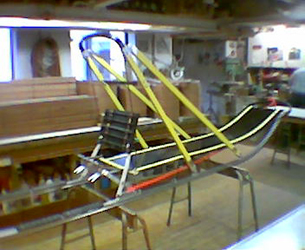Table of Contents
*
F.I.D.O.: Peter Schmidt Mikkelsen
*
A Conversation with Palle Norit
*
DNA Analysis of the Greenland Dog and the Canadian Inuit Dog
*
Pregnancy, Whelping and Pup Development in the ISD, Part 1
*
Product Review: Herculiner®
*
Tip for the Trail: Anti-fatigue Mats
*
In the News
*
Janice Howls: At the Heart of Greatness
*
IMHO: Training or Interference
Navigating This
Site
Index of articles by subject
Index
of back issues by volume number
Search The
Fan Hitch
Articles
to download and print
Ordering
Ken MacRury's Thesis
Our
comprehensive list of resources
Talk
to The
Fan Hitch
The Fan
Hitch home page
ISDI
home page
Editor's/Publisher's Statement
Editor: Sue Hamilton
Webmaster: Mark Hamilton
The Fan Hitch welcomes your letters, stories, comments and suggestions. The editorial staff reserves the right to edit submissions used for publication.
Contents of The Fan Hitch are protected by international copyright laws. No photo, drawing or text may be reproduced in any form without written consent. Webmasters please note: written consent is necessary before linking this site to yours! Please forward requests to Sue Hamilton, 55 Town Line Rd., Harwinton, Connecticut 06791, USA or mail@thefanhitch.org.
This site is dedicated to the Inuit Dog as well as related Inuit culture and traditions. It is also home to The Fan Hitch, Journal of the Inuit Sled Dog.

Nygaard
photo
A Reason to Follow the Iditarod
This is a far cry from our Inuit Dogs whose dog sledding tour de force is the ability to pull at least 125 pounds each over the most challenging of terrain in the most horrendous weather without quitting. In their native environment, an average good (long) day can be as much as 40 "arctic" miles.
Despite these contrasts, Inuit Dog enthusiasts may want
to keep an eye
on the March 5, 2005 Iditarod. Inuit Sled Dog
International's European
coordinator Ove Nygaard of Årnes, Norway has
been contracted
to build sleds for the two Norwegian competitors, 2003
Iditarod winner
Robert Sørly and 2005 Iditarod rookie Bjørnar Andersen.
Ove
will also be building sleds for mushers entered in the
Femundløpet
(February 4, 2005) and Finnmarksløpet (March 5, 2005)
races in Norway.
We hope mushers using Nygaard sleds do very well and they keep in mind while spending all those days on the runners that they have put their trust into the hands of an Inuit Dog enthusiast. Way to go, Ove! Talking about having a foot in each of two worlds!
Inuit Sled Dog DNA Samples Sought
Participation is easy and sampling materials are delivered to you free. An approximately 1-inch fine bristle brush on the end of a flexible handle is scrubbed inside the cheek pouch and or along the gum line for ten seconds. Inuit Sled Dog owners worldwide are urged to participate. To learn how you can contribute, write to the project's Breed Contact, Sue Hamilton, 55 Town Line Road, Harwinton, Connecticut 06791, USA or at qimmiq@snet.net.
Poor Hunting in Qaanaaq
A representative of the Inuit Circumpolar Conference (ICC) Greenland said an effort has been initiated to provide supplemental dog food and raise money to assist hunters in the region.
In an email to the ISDI, ICC Greenland said that so far a couple of tons of dog food plus its transportation to the hamlets in the Qaanaaq region had been donated from Ilulissat. A bank account has been set up for receiving contributions to support this effort and the dog team owners until the sea ice forms and they can go out hunting seals. The sea ice, normally set by the end of September, still had not yet formed in the region as of mid-November.
Fan Hitch Story Nominated for Writing Award